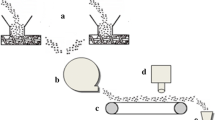Abstract
This article is the first of a series of articles detailing the development of near-infrared (NIR) methods for solid-dosage form analysis. Experiments were conducted at the Duquesne University Center for Pharmaceutical Technology to qualify the capabilities of instrumentation and sample handling systems, evaluate the potential effect of one source of a process signature on calibration development, and compare the utility of reflection and transmission data collection methods. A database of 572 production-scale sample spectra was used to evaluate the interbatch spectral variability of samples produced under routine manufacturing conditions. A second database of 540 spectra from samples produced under various compression conditions was analyzed to determine the feasibility of pooling spectral data acquired from samples produced at diverse scales. Instrument qualification tests were performed, and appropriate limits for instrument performance were established. To evaluate the repeatability of the sample positioning system, multiple measurements of a single tablet were collected. With the application of appropriate spectral preprocessing techniques, sample repositioning error was found to be insignificant with respect to NIR analyses of product quality attributes. Sample shielding was demonstrated to be unnecessary for transmission analyses. A process signature was identified in the reflection data. Additional tests demonstrated that the process signature was largely orthogonal to spectral variation because of hardness. Principal component analysis of the compression sample set data demonstrated the potential for quantitative model development. For the data sets studied, reflection analysis was demonstrated to be more robust than transmission analysis.
Similar content being viewed by others
References
FDA. PAT—A Framework for Innovative Manufacturing and Quality Assurance, Draft Guidance; 2003.
FDA. Guidance Documents, Available at: http://www.fda.gov/cder/guidance/index.htm. Accessed June 20, 2004.
Norris KH, Butler WL. Techniques for obtaining absorption spectra on intact biological samples.IRE transactions on bio-medical electronics. July 1961;8:153–157.
Williams P, Norris K, eds.Near-Infrared Technology in the Agricultural and Food Industries. St. Paul, MN: American Association of Cereal Chemists; 2001.
Ciurczak EW, Torlini RP, Demkowicz MP.Determination of particle size of pharmaceutical raw materials using near-infrared reflectance spectroscopy.Spectroscopy. (Duluth, MN, United States). 1986;1:36–39.
Shah NK, Gemperline PJ. Combination of the Mahalanobis distance and residual variance pattern recognition techniques for classification of near-infrared reflectance spectra.Analytical Chemistry. 1990;62:465–470.
El-Hagrasy AS, Morris HR, D’Amico F, Lodder RA, Drennen JK 3rd. Near-infrared spectroscopy and imaging for the monitoring of powder blend homogeneity.J Pharm Sci. 2001;90:1298–1307.
Sekulic SS, Wakeman J, Doherty P, Hailey PA. Automated system for the on-line monitoring of powder blending processes using near-infrared spectroscopy. Part II. Qualitative approaches to blend evaluation.J Pharm Biomed Anal. 1998;17:1285–1309.
Wargo DJ, Drennen JK. Near-infrared spectroscopic characterization of pharmaceutical powder blends.Journal of Pharmaceutical and Biomedical Analysis. 1996;14:1415–1423.
Rantanen J, Antikainen O, Mannermaa J-P, Yliruusi J. Use of the near-infrared reflectance method for measurement of moisture content during granulation.Pharmaceutical Development and Technology. 2000;5:209–217.
Rantanen J, Jørgensen A, Räsänen E, et al. Process analysis of fluidized bed granulation.AAPS PharmSciTech. 2001;2:21.
Bijlani VJ, Delado-Lopez M, Adeyeye CM, Drennen JK. Near infrared spectroscopy for monitoring the hardness of roller compaction ribbons.NIR news. 2002;13:8–14.
Morris KR, Stowell JG, Byrn SR, Placette AW, Davis TD, Peck GE. Accelerated fluid bed drying using NIR monitoring and phenomenological modeling.Drug Development and Industrial Pharmacy. 2000;26:985–988.
Ciurczak EW, James K, Drennen I.Pharmaceutical and Medical Applications of Near-Infrared Spectroscopy. New York, NY: Marcel Dekker Inc; 2002.
Ciurczak EW. Growth of near-infrared spectroscopy in pharmaceutical and medical sciences. In: DJ Bornhop, DA Dunn, RP Mariella Jr, CJ Murphy, DV Nicolau, S Nie, M Palmer, R Raghavachari, eds. Proceedings of SPIE Volume: 4626. Bellingham, WA: SPIE; 2002:116–125.
Brown SD, Sum ST, Despagne F, Lavine BK. Chemometrics.Analytical Chemistry. 1996;68:21–61.
Mobley PR, Kowalski BR, Workman JJ Jr, Bro R. Review of Chemometrics Applied to Spectroscopy: 1985–95, Part 2.Applied Spectroscopy Reviews. 1996;31:347–368.
Workman JJ Jr, Mobley PR, Kowalski BR, Bro R. Review of chemometrics applied to spectroscopy: 1985–95, Part I.Applied Spectroscopy Reviews. 1996;31:73–124.
Drennen JK, Lodder RA. Nondestructive near-infrared analysis of intact tablets for determination of degradation products.Journal of Pharmaceutical Sciences. 1990;79:622–627.
Iyer M, Morris HR, Drennen JK III. Solid dosage form analysis by near infrared spectroscopy: Comparison of reflectance and transmittance measurements including the determination of effective sample mass.Journal of Near Infrared Spectroscopy. 2002;10:233–245.
Kirsch JD, Drennen JK. Determination of film-coated tablet parameters by near-infrared spectroscopy.J Pharm Biomed Anal. 1995;13:1273–1281.
Kirsch JD, Drennen JK. Near-infrared spectroscopy: applications in the analysis of tablets and solid pharmaceutical dosage forms.Appl Spectr Rev. 1995;30:139–174.
Kirsch JD, Drennen JK. Nondestructive tablet hardness testing by near-infrared spectroscopy: a new and robust spectral best-fit algorithm.J Pharm Biomed Anal. 1999;19:351–362.
Ingle JD, Crouch SR.Spectrochemical Analysis. Upper Saddle River, NJ: Prentice-Hall; 1988.
United States Pharmacopeial Convention I. [1119] Near-Infrared Spectrophotometry.USP-NF, Second Supplement. Rockville, MD USA: United States Pharmacopeial Convention Inc; 2003;3337–3344.
Cogdill RP, Anderson CA, Drennen JK. Process Analytical Technology Case Study, Part III: Calibration Monitoring and Transfer.AAPS PharmSciTech. 2005; In press.
Sparen A, Malm M, Josefson M, Folestad S, Johansson J. Light leakage effects with different sample holder geometries in quantitative near-infrared transmission spectroscopy of pharmaceutical tablets.Applied Spectroscopy. 2002;56:586–592.
ASTM.International Standard E2363-04 Standard Terminology Relating to Process Analytical Technology in the Pharmaceutical Industry; 2004.
Cogdill RP, Anderson CA, Delgado-Lopez M, et al. Process Analytical Technology Case Study, Part II: Development and Validation of Quantitative for Tablet API Content and Hardness.AAPS PharmSciTech. 2005;E273–E283.
AACC. “Near-Infrared Methods: Guidelines for Model Development and Maintenance,” AACC Method 39-00.Approved Methods of the American Association of Cereal Chemists. 10 ed. St. Paul, MN: AACC Press; 1999.
Author information
Authors and Affiliations
Corresponding author
Additional information
Published: October 6, 2005
The views presented in this article do not necessarily reflect those of the Food and Drug Administration.
Rights and permissions
About this article
Cite this article
Cogdill, R.P., Anderson, C.A., Delgado-Lopez, M. et al. Process analytical technology case study part I: Feasibility studies for quantitative near-infrared method development. AAPS PharmSciTech 6, 37 (2005). https://doi.org/10.1208/pt060237
Received:
Accepted:
DOI: https://doi.org/10.1208/pt060237




